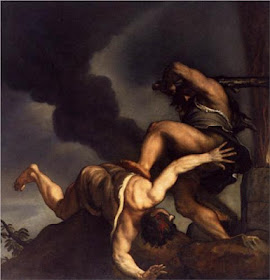Titian’s so-called
“Sacred and Profane Love” is one of the most important and mysterious paintings
of the Renaissance. One of its most mysterious features is the relief on the
front of the sarcophagus like fountain.
In my interpretation of the painting as the “Conversion of Mary Magdalen” I was able to identify the scenes depicted on the
relief and fit them into the overall subject of the painting. The explanation
of the relief, despite its central position, had defied even the greatest scholars.
Erwin Panofsky included a discussion of “ The
Sacred and Profane Love” in his long essay on the Neoplatonic Movement in
Florence and North Italy. The essay was published in 1939 along with others in
his classic work, “Studies in Iconology”. The essay explored the philosophical
work of Marsilio Ficino, and Panofsky used Titian’s painting as an example of Neo-Platonic themes. His essay became the starting point for all future discussions of the painting, and his "Two Venus" interpretation was widely accepted.
However, he did not discuss the relief and just
relegated this admission to a footnote. “The reliefs on the sarcophagus invented
by Titian in the classical style, have not yet been explained.”* In the 1962
paperback re-issue Panofsky noted some criticisms of his essay but he still did
not attempt to discuss the relief or alter the footnote. He was still not able
to fit this piece of the puzzle into the picture.
In 1978 David Rosand accepted Panofsky’s
Neo-Platonic "Twin Venus" interpretation and did attempt an
explanation of the relief.
a third type is depicted on Titian's invented sarcophagus relief: bestial love-pure lust, which seeks not beauty and its procreation but rather mere satisfaction of sexual appetite-is symbolized by the unbridled force and the accompanying acts of passion and violence.**
A few years later Rona Goffen, who wrote more on the painting than any one else, was obviously unsatisfied with Rosand's explanation but could only hazard a guess about the relief.
Perhaps Titian’s fictive relief—a pastiche of antique motifs—alludes to that myth (rape of the Sabine women)…***
Finally, in his Titian catalog of 2007 Peter Humfrey could only call the
relief “Titian’s own invention" and leave it at that.#
The relief is not an insignificant detail. It
is boldly presented right in the center of the painting. Why could these four
great scholars with all their skill and ability not be able to see its real
meaning? Is it just my imagination that led me to see three great sinners
depicted on the relief in a painting whose subject is Mary Magdalen, the
greatest of sinners? On the viewer's right is Adam and Eve standing around the Tree. On the left is a man falling from a horse that can only be St. Paul. But just to the right of center there is an act of violence that depicts Cain and Abel.
This striking image depicts a man with his arm raised as if to strike a blow on the man lying prone on the ground. Is this such an unusual image? Is it Titian's own invention or is it a commonplace in depictions of Cain and Abel. the first instance of sin after the Fall?
This striking image depicts a man with his arm raised as if to strike a blow on the man lying prone on the ground. Is this such an unusual image? Is it Titian's own invention or is it a commonplace in depictions of Cain and Abel. the first instance of sin after the Fall?
Titian himself painted Cain and Abel approximately 30 years after the "Sacred and Profane Love".
 |
| Titian: Cain and Abel |
Here is Tintoretto's version of the act of violence.
 |
| Tintoretto: Cain and Abel |
Rather than inventing this scene it would appear that Titian and Tintoretto were just following the standard universally accepted template for Cain's murder of his brother. In the Ghent Altarpiece Jan van Eyck used the same motif and even painted it as a sculpted relief.
 |
| Jan van Eyck: Ghent Altarpiece detail |
I believe that any Venetian contemporary of Titian's would have immediately recognized the image of Cain and Abel on the relief in the "Sacred and Profane Love." This detail on the relief is enough by itself to make us consider the possibility that the "Sacred and Profane Love" is a sacred subject. ###
*Panofsky, Erwin: “The Neoplatonic Movement in
Florence and North Italy (Bandinelli and Titian),” in Studies in Iconology, Humanistic Themes in the Art of the
Renaissance, Oxford 1939, Reprint 1962, p. 152.
**David
Rosand: Titian, New York 1978. P.
80.
***Goffen, Rona: Titian’s Sacred and Profane Love and Marriage, The
Expanding Discourse, Feminism and Art History, ed. Norma Broude and
Mary D. Garrard, NY, 1992, p. 121.
#Peter Humfrey, Titian, 2007, p. 47.











